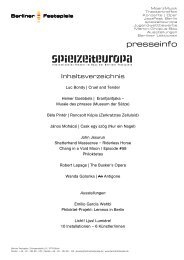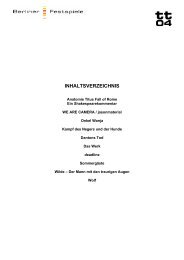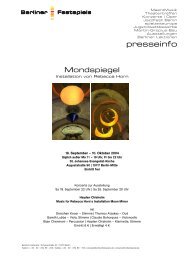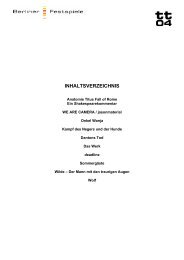konzerte04-pressemappe.pdf - Berliner Festspiele
konzerte04-pressemappe.pdf - Berliner Festspiele
konzerte04-pressemappe.pdf - Berliner Festspiele
Erfolgreiche ePaper selbst erstellen
Machen Sie aus Ihren PDF Publikationen ein blätterbares Flipbook mit unserer einzigartigen Google optimierten e-Paper Software.
obtained in England on the 5th January a patent number 5065 for fi xing iron bars to the wooden braces<br />
by means of bolts, passing through holes in the soundboard, which is still the method used for<br />
fi xing the iron frame. Controversy was to arise between Erard and Broadwood as to who fi rst came<br />
up with the idea. Also in this submission were improvements to the wrest plank (or tuning pin block)<br />
and action. Rarely did piano makers submit just one patent on a submission, probably because of the<br />
cost involved. In 1875 it was £0. 1s. 6d. Erard, unlike Brinsmead, produced full-sized scale drawings<br />
with his patents.<br />
Stodart, on the 10 May 1851, sent a letter to The Times promoting their patent of 1820 for metal<br />
‚compensation‘ frames composed of plates and tubular braces. This was to increase stability during<br />
changes in humidity. The tension of the brass strings was borne by brass tubes and that of the iron<br />
strings by iron tubes. Stodart fi tted his bars to most of his pianos, and Pierre Erard obtained a related<br />
French patent in 1822, but made few instruments with this device. Stodart‘s successful use of it was<br />
due mostly to the greater strength of his tubular bars. Stodart abandoned this by 1860.<br />
Because of the revolution the organ at the Tuilleries in France was destroyed, and in 1830 Sebastian<br />
Erard was appointed to restore it, but he was unable to complete the restoration, as he died in<br />
August 1831. In 1835 Pierre Erard was petitioning the Privy Council, claiming that in England „certain<br />
unfounded notions were circulated to their disadvantage.“ During the court of inquiry he claimed that<br />
Erard‘s pianos „had a great deal more strength and power than any other instrument and great effect<br />
in accompanying the voice.“<br />
Three years later Pierre used a metal bridge with holes through which the upper strings passed. In<br />
1839 trouble arose when Erard discovered Broadwood making pianos with studs, which was Erard‘s<br />
invention of 1808. At the exhibition of 1851 the Gold Medal went to Erard. Four years later Erard, with<br />
425 men, turned out 1500 pianos. Their London branch stopped trading in Great Portland Street in<br />
1890, but a hall bearing the fi rm‘s name survived until modern times. From 1903 to 1953 the fi rm<br />
traded as Blondelet Cie. In 1960 Erard merged with Gaveau. The two great French fi rms of Erard and<br />
Pleyel amalgamated in 1961. Yet, just years earlier, Erard and Pleyel were trying to outdo each other<br />
with a duel of the harps, much to the delight of the concert-going public of the day. Pleyel commissioned<br />
Debussy and Erard commissioned Ravel. Sadly, it seems they were wound up in 1971. In late<br />
1971 the name Erard was taken over by the West German maker Schimmel.<br />
Barrie Heaton © copyright 1998-2002.








